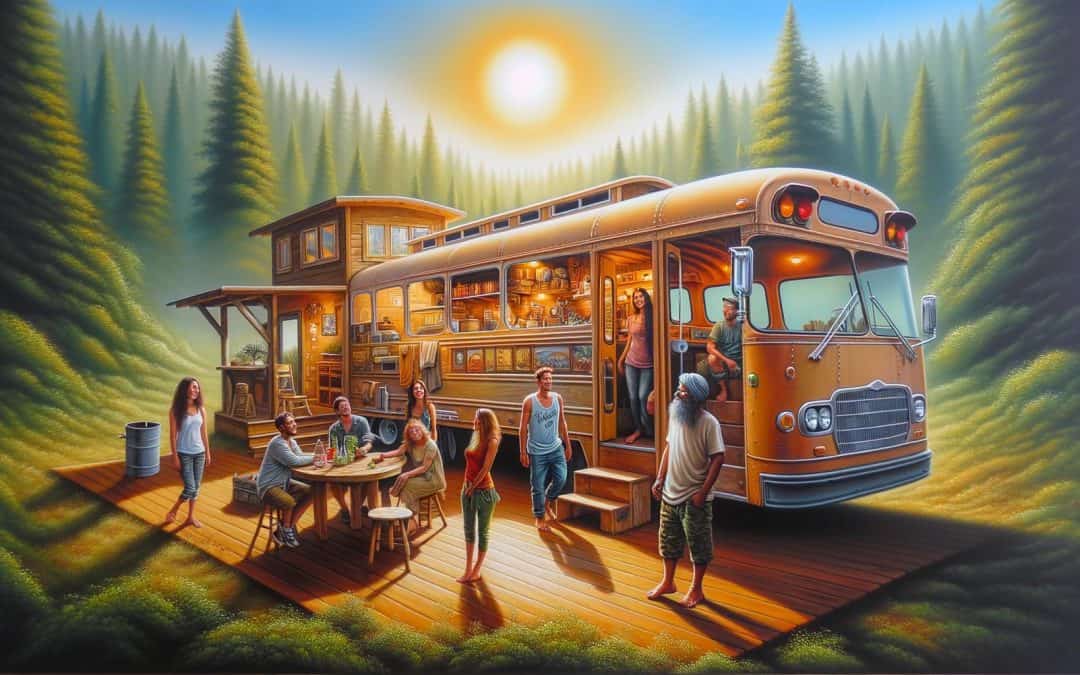At Outbuilders, we’ve seen a surge in interest for unique tiny home solutions. One trend that’s caught our eye is the growing popularity of bus conversions.
These mobile tiny homes offer a blend of adventure and minimalist living. In this post, we’ll take you on tiny home tours of bus conversions, exploring their design, systems, and the practicalities of life on wheels.
What Makes a Good Bus for Conversion?
Choosing the Right Bus
At Outbuilders, we’ve noticed a rise in bus conversions as an alternative to traditional tiny homes. While we focus on custom storage solutions, we admire the creativity in transforming buses into livable spaces.

School buses (aka “skoolies”) stand out as popular choices due to their robust construction and spacious interiors. Transit and coach buses also offer viable options, each with unique advantages.
School buses typically cost $3,000 to $7,000 (depending on condition). They’re built to last, often running for 250,000 miles or more with proper maintenance. Their height allows for comfortable standing room, which is essential for long-term living.
Transit buses, though less common, offer wider bodies that can benefit certain floor plans. Coach buses often come with undercarriage storage, a potential game-changer for those needing extra space.
Navigating Legal Requirements
Understanding the legal landscape is essential before starting a bus conversion project. Each state has different regulations for registering and operating converted buses. Some areas require you to register your converted bus as an RV for full-time living.
Insurance presents another challenge. Many insurers, including Progressive, won’t insure converted school buses at all. If you’re planning a DIY “skoolie” conversion, it’s important to look into obtaining insurance during the planning stages of your project.
Cost Considerations
Bus conversions can be more economical than traditional tiny homes. However, it’s important to note that there is no fixed price for a conversion. The cost can vary greatly depending on numerous factors, including the quality of materials and construction.
It’s important to factor in ongoing costs. Fuel efficiency for converted buses typically ranges from 6 to 10 miles per gallon, which can add up quickly for extensive travel. Maintenance costs can also surpass those of a stationary tiny home.
Planning Your Conversion
Thorough planning is key before starting your conversion. Consider your lifestyle needs, budget, and DIY skills. Many successful converters spend months researching and designing before making their first cut.
Bus conversions offer unique opportunities for customization and mobility, but they also come with distinct challenges. Proper insulation, for instance, is vital for comfort in various climates. At Outbuilders, we’ve seen the importance of insulation in our custom sheds and cabins, and the same principle applies to bus conversions.
As we move forward, let’s explore the creative ways people maximize space in these unique mobile homes. The next section will showcase innovative design and layout ideas that transform buses into comfortable living spaces.
How to Design Your Bus Conversion
Optimizing Floor Plans
The most popular floor plans for bus conversions follow a linear layout. Many converters place a bedroom at the back, a living area in the middle, and a kitchen and bathroom near the front. This arrangement allows for clear separation of spaces and efficient use of plumbing and electrical systems.

Some innovative designs include:
- Raised platform beds with storage underneath
- Convertible dining areas that transform into guest beds
- Slide-out sections to increase living space when parked
Smart Storage Solutions
Storage is critical in a bus conversion. Some effective solutions include:
- Built-in cabinets along the ceiling
- Under-floor compartments
- Multi-functional furniture with hidden storage
Many successful bus conversions incorporate custom-built furniture to fit the unique dimensions of the bus. This approach maximizes space utilization and creates a cohesive look.
Clever Design Tricks
To make your bus feel more spacious:
- Use light colors for walls and ceilings
- Install large windows or skylights for natural light
- Choose open shelving instead of closed cabinets in some areas
Personalization Matters
Your bus is your home. Converters often add personal touches like:
- Custom artwork or murals on interior walls
- Unique tile work in bathrooms or kitchens
- Handcrafted details (like live-edge countertops or custom door handles)
Material Selection
The choice of materials can significantly impact the overall feel and functionality of your bus conversion. Try to select lightweight yet durable materials to minimize the overall weight of your conversion. Some popular options include:
- Bamboo flooring (eco-friendly and lightweight)
- Recycled plastic countertops (durable and easy to clean)
- Cork wall coverings (incredible insulator and sound break, with anti-bug and mildew qualities, plus 100% sustainable)
The design principles used in bus conversions often mirror those applied in tiny homes and other small living spaces. The key is to plan carefully, maximize every inch of space, and create a design that reflects your personal style and needs.
Now that we’ve explored design considerations, let’s examine the essential systems that make comfortable living possible in a converted bus.
How to Power and Equip Your Bus Conversion
Electrical Systems: Powering Your Mobile Home
Bus converters often choose a combination of power sources. Solar panels have become a popular choice, with the average panel conversion efficiency increasing from 15% to over 23% in recent years. This setup powers basic appliances and electronics, but requires battery storage for nighttime use.

For higher power needs, a generator serves as a good backup. A 2000-watt inverter generator, suitable for most bus conversions, costs about $500-$1000. However, generators produce noise and require fuel, so users should limit their use.
Shore power hookups prove essential for extended stays at RV parks. The installation of a 30-amp RV inlet allows connection to campground electricity, providing unlimited power when available.
Water Systems: Staying Clean and Hydrated
Water management plays a critical role in a bus conversion. A typical setup includes:
- Freshwater tank (40-100 gallons)
- Greywater tank for used water from sinks and showers
- Blackwater tank for toilet waste (if using a traditional flush toilet)
Many converters prefer composting toilets to eliminate the need for a blackwater tank. These are easy to install, require little to no plumbing, and are ideal for skoolie conversions.
For showers, on-demand water heaters prove popular. They offer compact design and only heat water when needed, saving energy. A quality unit costs between $200-$500.
Climate Control: Comfort in All Weather
Proper insulation serves as the first line of defense against temperature extremes. Spray foam insulation, while more expensive, provides excellent R-value and helps soundproof the bus.
For heating, many converters use propane heaters like the popular Mr. Buddy series (starting at around $100). Wood stoves offer another option, providing a cozy aesthetic, but require more installation work and safety considerations.
Cooling presents a challenge in a metal bus. Roof-mounted RV air conditioners work effectively but consume significant power. Many bus dwellers rely on good ventilation, using multiple fans and strategically placed windows to create airflow.
Professional Help and Planning
The implementation of these systems requires careful planning and often professional assistance, especially for electrical work. However, the result creates a comfortable, functional home ready for road adventures.
Final Thoughts
Bus conversions offer a unique blend of adventure, customization, and minimalist living. These mobile tiny homes provide freedom to explore while carrying the comforts of home. The ability to design every aspect of your living space allows for a truly personalized experience.

Careful consideration is essential before starting a bus conversion project. You must assess your budget, skills, and long-term goals, as well as research local regulations regarding registration and insurance. Numerous resources are available for those intrigued by tiny home tours of bus conversions, including online communities, forums, and social media groups.
At Outbuilders, we specialize in creating custom storage solutions, including sheds and cabins, that can serve as stationary tiny homes. Our high-quality, personalized structures offer many benefits of tiny living without the need for constant mobility. Whether you choose a bus conversion or another form of alternative housing, create a space that aligns with your lifestyle and values.







Recent Comments